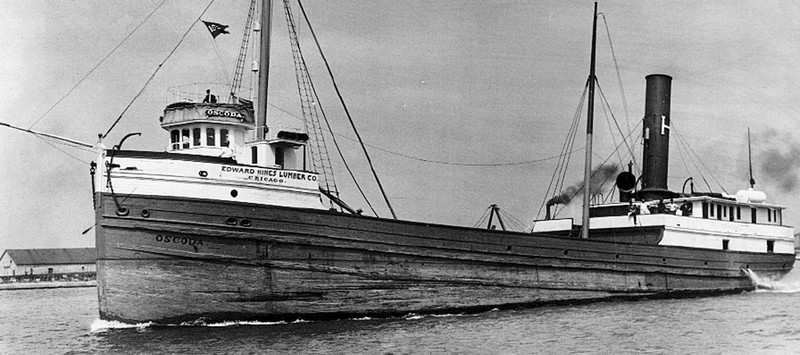Oscoda
Introduction
Text-to-speech Audio
Oscoda Built – 1878 175 ft. x 32 ft. x 13 ft. The Oscoda was a steam barge that was used as a lumber hooker for many years. She was built by Simon Langell but in the Truesdail Shipyard. On Feb. 6, 1878, the St. Clair Republican newspaper reported that “Mr. Langell is now in the woods getting out timber for the vessel.” By May, it was reported that “Langell and his fifty men were hard at work on the barge.” In November 1914, the Oscoda was loaded with lumber herself and towing two additional barges bound for Chicago. The crew decided to make a course change to proceed along the west side of Lake Michigan. The Oscoda was driven ashore by a November winter gale and heavy snow squall. There were no casualties, but the crew had an harrowing experience getting to one of the other barges before the Oscoda was smashed to pieces on Pelke Reef, 12 miles east of Naubinway on the north shore of the Straits of Mackinac. She eventually sank near St. Helena Island.
Images
Great Lakes lumber "hooker" Oscoda underway in the St. Clair River.

Brass plaque on the Boardwalk presenting the year built and length of the Oscoda.

Backstory and Context
Text-to-speech Audio
As you walked south from the “Starting Point” plaque to this location on the St. Clair River Boardwalk, the brass plaque marked Oscoda on the boardwalk represents the bow of the Great Lakes freighter Oscoda. The brass plaque at the Starting Point represents the stern or back of every ship included in this walking tour. By looking back to the starting point, you are able to get an estimate of the size or 175 ft. length of the Oscoda.
Sources
St. Clair, by Charles Homberg, St. Clair Historical Commission, 2007; St. Clair Historical Museum and Research Center archives; Great Lakes Ships data base, Alpena County George N. Fletcher Public Library, Alpena, Michigan; Great Lakes Freighters by Rand Shackleton, Thunder Bay Press, 2003.
